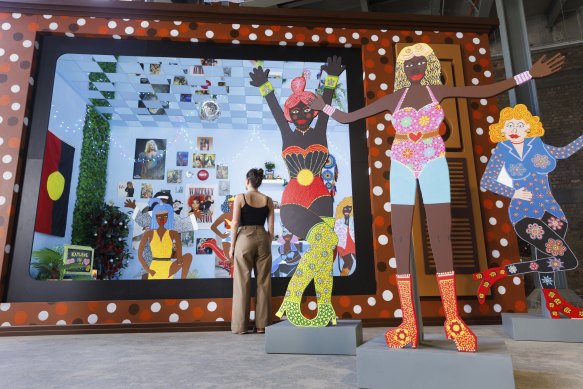- Exclusive
- Culture
- Art & design
- Arts
This was published 8 months ago
The giant art installation taking over White Bay Power Station
By Linda Morris
A gargantuan television set adorned with cut-out, larger-than-life cultural figures including Dolly Parton, has been set up inside the refurbished White Bay Power Station, as the venue prepares to open its doors to the public for the first time in 100 years for the 50th birthday of the Biennale of Sydney.
But just days out from its launch, the Inner West Council says it’s scrambling to organise shuttle bus services for art lovers, after the Environment Protection Authority confirmed delays to the reopening of the Rozelle Parklands, which provide pedestrian access near the Power Station and the light rail station.

Kaylene TV, an artwork by Kaylene Whiskey, is installed inside the White Bay Power Station.Credit: Max Mason-Hubers
Mayor Darcy Byrne said he worried that without additional public transport links from the CBD, the ability of the White Bay Power Station to prove itself as a major arts venue and drawcard could be compromised.
Ninety-six artists and collectives from 50 countries will be represented at the 24th edition of the Biennale of Sydney, Australia’s largest festival of contemporary art.
Making its debut as an arts venue for the Biennale is the once-derelict White Bay Power Station where monumental works of art have been installed and next Friday’s ticketed dance party, Lights On, on March 8, will mark the start of three months of free cultural events across several city venues.
More than $100 million has been invested in White Bay’s restoration and remediation to rid it of asbestos, lead dust, and pigeon droppings, and replace rusting metalwork and broken glass.
Key among the art projects to be unveiled next week for the Biennale’s Ten Thousand Suns is a large-scale portrait by Dylan Mooney of the late Indigenous gay activist Malcolm Cole dressed as Captain Cook rising 16 metres from the first floor of the Boiler Room.
On the ground floor will be the interactive television set by Kaylene Whiskey, the biggest project of her career and her first working with wood, instead of canvas or paper.
“I have made a lot of sculptures, they’re cut-out plywood figures of some of my heroes, like Wonder Woman, Cat Woman, Tina Turner and, of course, Dolly Parton,” she said. “They’re having a party inside a giant TV and the best thing is that the audience can go inside the TV too and join the party! It is like a Kaylene Whiskey painting that you can walk into.
“When I was a young girl I would see Wonder Woman on TV and in comics and I always loved seeing her transform into a superhero - a strong kungka (woman) who could do anything! I also loved her outfit, especially her gold headband and red boots! Now I paint Anangu Wonder Woman, so it’s like one of us girls from my community has transformed into a superhero, here to save the day!”

Artistic Directors of the upcoming 24th Biennale of Sydney Cosmin Costinaș and Inti Guerrero with an artwork by Eric-Paul Riege, installed at the old White Bay Power Station. Credit: Maxv Mason-Hubers
For the first time in the Biennale’s 50 years, the festival will have a float in Saturday’s Mardi Gras parade, featuring Cole’s twin brother, Robert.
He will be dressed as the British explorer, in remembrance of his sibling who had also donned the Cook costume to mark the 1988 Bicentenary.
Co-artistic director Cosmin Costinaș said the Biennale was now at the exciting phase of preparations where drawings and artists’ imagination had come together in reality.
Filling the huge volumes of White Bay required more careful thinking and strategies than other venues of the Biennale, Costinaș said. A projection of five photographic portraits of young Indigenous dancers created by William Yang will greet arriving Biennale visitors.
Costinaș′ collaborator Inti Guerrero said the surprise for audiences would be in encountering art in a place they have never experienced it before. He is a great admirer of the stringed kites made by Indigenous groups of Central America.
“These kites are normally shown in community festivals but seeing them elevated in this space is magical. They have such a presence that contrasts with a vernacular and traditional world coming into this former industrial ruin and heartland,” he said.
As well as White Bay, the Biennale will be presented in other venues including the Art Gallery of NSW, Artspace, Museum of Contemporary Art Australia, and for the first time at Chau Chak Wing Museum at the University of Sydney, and UNSW Galleries.
Rozelle Parklands - which light rail patrons will need to cross to arrive at the rejuvenated power station - remains closed to the public for another month following the discovery of bonded asbestos in the newly landscaped grounds.
Dedicated buses will run from Sydney’s CBD to the forecourt of the Power Station while regular bus services will also operate along Victoria Road and Mullens Street.
Remediation works continue at Rozelle Parklands and Transport for NSW said it intends to open some shared pathways as soon as possible to help connect the light rail stop at Rozelle Bay with the Biennale.
A proposal by event organisers to establish a temporary dedicated ferry service to White Bay was explored but was unable to proceed due to challenges with providing safe access along Robert Street to the Port Authority of NSW area.
Find out the next TV, streaming series and movies to add to your must-sees. Get The Watchlist delivered every Thursday.